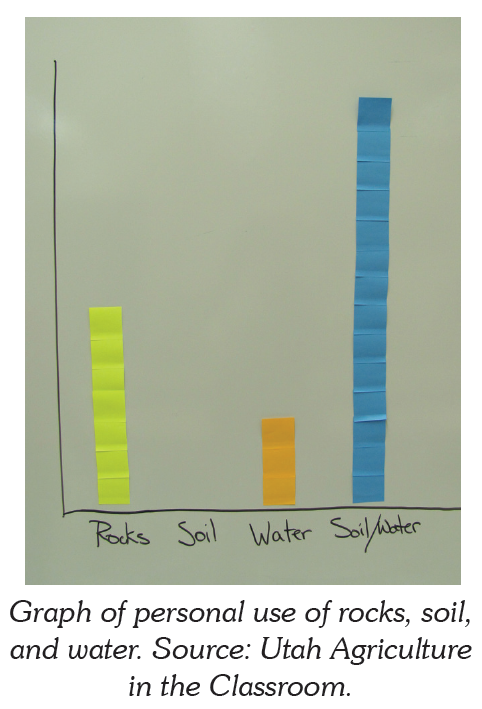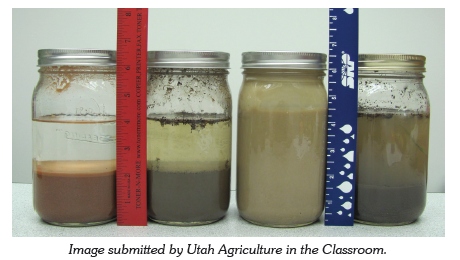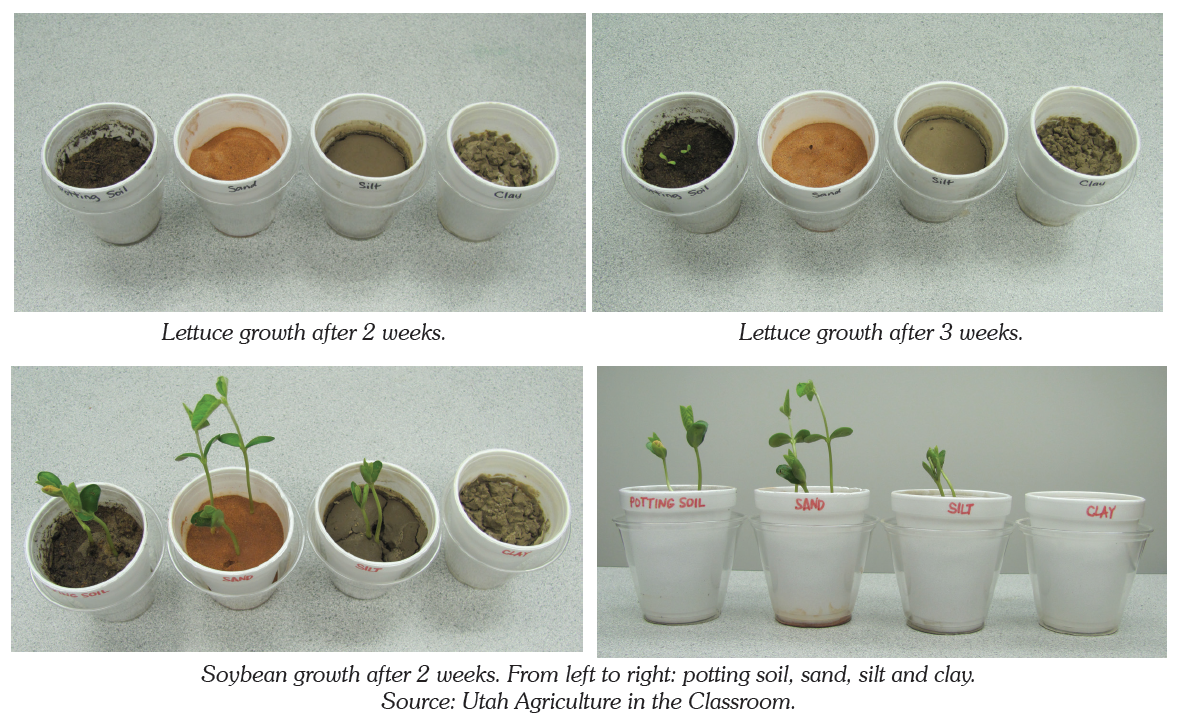Texturing: The Big Picture
Students explore soil textures and investigate the connections between soil texture, water, and plant growth.
Background
Lesson Activities
Recommended Companion Resources
Credits
Author
Debra Spielmaker | Utah Agriculture in the Classroom
Standards
Texas Content Area Standards
-
ELA: K.110.2.b.1
Developing and sustaining foundational language skills: listening, speaking, discussion, and thinking - - oral language. The student develops oral language through listening, speaking, and discussion.
- ELA: K.110.2.b.1.C: share information and ideas by speaking audibly and clearly using the conventions of language
- ELA: K.110.2.b.1.D: work collaboratively with others by following agreed-upon rules for discussion, including taking turns;
-
ELA: 1.110.3.b.1
Developing and sustaining foundational language skills: listening, speaking, discussion, and thinking - - oral language. The student develops oral language through listening, speaking, and discussion.
- ELA: 1.110.3.b.1.C: share information and ideas about the topic under discussion, speaking clearly at an appropriate pace and using the conventions of language
- ELA: 1.110.3.b.1.D: work collaboratively with others by following agreed-upon rules for discussion, including listening to others, speaking when recognized, and making appropriate contributions
-
ELA: 2.110.4.b.1
Developing and sustaining foundational language skills: listening, speaking, discussion, and thinking -- oral language. The student develops oral language through listening, speaking, and discussion.
- ELA: 2.110.4.b.1.C: share information and ideas that focus on the topic under discussion, speaking clearly at an appropriate pace and using the conventions of language
- ELA: 2.110.4.b.1.D: work collaboratively with others by following agreed-upon rules for discussion, including listening to others, speaking when recognized, making appropriate contributions, and building on the ideas of others
-
Social Studies: 2.113.13.c.16
Social studies skills. The student communicates in written, oral, and visual forms. The student is expected to:
- Social Studies: 2.113.13.c.16.E: communicate information visually, orally, or in writing based on knowledge and experiences in social studies
- Social Studies: 2.113.13.c.16.F: create written and visual material such as stories, maps, and graphic organizers to express ideas
-
Social Studies: K.113.11.c.14
Social studies skills. The student communicates in oral and visual forms. The student is expected to:
- Social Studies: K.113.11.c.14.C: communicate information visually, orally, or in writing based on knowledge and experiences in social studies
- Social Studies: K.113.11.c.14.D: create and interpret visuals, including pictures and maps
-
Social Studies: 1.113.12.c.17
Social studies skills. The student communicates in oral, visual, and written forms. The student is expected to:
- Social Studies: 1.113.12.c.17.C: communicate information visually, orally, or in writing based on knowledge and experiences in social studies
- Social Studies: 1.113.12.c.17.D: create and interpret visual and written material
-
Science: 2.112.4.b.1
Scientific and engineering practices. The student asks questions, identifies problems, and plans and safely conducts classroom, laboratory, and field investigations to answer questions, explain phenomena, or design solutions using appropriate tools and models. The student is expected to:
- Science: 2.112.4.b.1.E: collect observations and measurements as evidence
- Science: 2.112.4.b.1.F: record and organize data using pictures, numbers, words, symbols, and simple graphs
-
Science: K.112.2.b.1
Scientific and engineering practices. The student asks questions, identifies problems, and plans and safely conducts classroom, laboratory, and field investigations to answer questions, explain phenomena, or design solutions using appropriate tools and models. The student is expected to:
- Science: K.112.2.b.1.E: collect observations and measurements as evidence.
- Science: K.112.2.b.1.F: record and organize data using pictures, numbers, words, symbols, and simple graphs.
-
Science: K.112.2.b.3
Scientific and engineering practices. The student develops evidence-based explanations and communicates findings, conclusions, and proposed solutions. The student is expected to:
- Science: K.112.2.b.3.A: develop explanations and propose solutions supported by data and models.
- Science: K.112.2.b.3.B: communicate explanations and solutions individually and collaboratively in a variety of settings and formats.
- Science: K.112.2.b.3.C: listen actively to others' explanations to identify important evidence and engage respectfully in scientific discussion.
-
Science: K.112.2.b.5
Recurring themes and concepts. The student uses recurring themes and concepts to make connections across disciplines. The student is expected to:
- Science: K.112.2.b.5.A: identify and use patterns to describe phenomena or design solutions.
- Science: K.112.2.b.5.G: describe how factors or conditions can cause objects, organisms, and systems to either change or stay the same.
-
Science: K.112.2.b.10
Earth and space. The student knows that the natural world includes earth materials and systems that can be observed. The student is expected to:
- Science: K.112.2.b.10.B: observe and describe weather changes from day to day and over seasons.
-
Science: K.112.2.b.11
Earth and space. The student knows that earth materials are important to everyday life. The student is expected to observe and generate examples of practical uses for rocks, soil, and water.
- Science: K.112.2.b.11: Earth and space. The student knows that earth materials are important to everyday life. The student is expected to observe and generate examples of practical uses for rocks, soil, and water.
-
Science: K.112.2.b.13
Organisms and environments. The student knows that organisms resemble their parents and have structures and undergo processes that help them interact and survive within their environments. The student is expected to:
- Science: K.112.2.b.13.A: identify the structures of plants, including roots, stems, leaves, flowers, and fruits.
-
Science: 1.112.3.b.1
Scientific and engineering practices. The student asks questions, identifies problems, and plans and safely conducts classroom, laboratory, and field investigations to answer questions, explain phenomena, or design solutions using appropriate tools and models. The student is expected to:
- Science: 1.112.3.b.1.E: collect observations and measurements as evidence.
- Science: 1.112.3.b.1.F: record and organize data using pictures, numbers, words, symbols, and simple graphs.
-
Science: 1.112.3.b.3
Scientific and engineering practices. The student develops evidence-based explanations and communicates findings, conclusions, and proposed solutions. The student is expected to:
- Science: 1.112.3.b.3.A: develop explanations and propose solutions supported by data and models.
- Science: 1.112.3.b.3.B: communicate explanations and solutions individually and collaboratively in a variety of settings and formats.
- Science: 1.112.3.b.3.C: listen actively to others' explanations to identify important evidence and engage respectfully in scientific discussion.
-
Science: 1.112.3.b.5
Recurring themes and concepts. The student uses recurring themes and concepts to make connections across disciplines. The student is expected to:
- Science: 1.112.3.b.5.A: identify and use patterns to describe phenomena or design solutions.
- Science: 1.112.3.b.5.E: identify forms of energy and properties of matter.
-
Science: 1.112.3.b.6
Matter and its properties. The student knows that objects have physical properties that determine how they are described and classified. The student is expected to:
- Science: 1.112.3.b.6.A: classify objects by observable physical properties, including shape, color, and texture, and attributes such as larger and smaller and heavier and lighter.
- Science: 1.112.3.b.6.B: explain and predict changes in materials caused by heating and cooling.
-
Science: 1.112.3.b.10
Earth and space. The student knows that the natural world includes earth materials that can be observed in systems and processes. The student is expected to:
- Science: 1.112.3.b.10.A: investigate and document the properties of particle size, shape, texture, and color and the components of different types of soils such as topsoil, clay, and sand.
-
Science: 1.112.3.b.11
Earth and space. The student knows that earth materials and products made from these materials are important to everyday life. The student is expected to:
- Science: 1.112.3.b.11.B: explain why water conservation is important.
-
Science: 1.112.3.b.12
Organisms and environments. The student knows that the environment is composed of relationships between living organisms and nonliving components. The student is expected to:
- Science: 1.112.3.b.12.B: describe and record examples of interactions and dependence between living and nonliving components in terrariums or aquariums.
- Science: 1.112.3.b.12.C: identify and illustrate how living organisms depend on each other through food chains.
-
Science: 2.112.4.b.3
Scientific and engineering practices. The student develops evidence-based explanations and communicates findings, conclusions, and proposed solutions. The student is expected to:
- Science: 2.112.4.b.3.A: develop explanations and propose solutions supported by data and models
- Science: 2.112.4.b.3.B: communicate explanations and solutions individually and collaboratively in a variety of settings and formats
- Science: 2.112.4.b.3.C: listen actively to others' explanations to identify important evidence and engage respectfully in scientific discussion
-
Science: 2.112.4.b.5
Recurring themes and concepts. The student uses recurring themes and concepts to make connections across disciplines. The student is expected to:
- Science: 2.112.4.b.5.A: identify and use patterns to describe phenomena or design solutions
- Science: 2.112.4.b.5.E: identify forms of energy and properties of matter
-
Science: 2.112.4.b.10
Earth and space. The student knows that the natural world includes earth materials that can be observed in systems and processes. The student is expected to:
- Science: 2.112.4.b.10.A: investigate and describe how wind and water move soil and rock particles across the Earth's surface such as wind blowing sand into dunes on a beach or a river carrying rocks as it flows
-
Science: 2.112.4.b.12
Organisms and environments. The student knows that living organisms have basic needs that must be met through interactions within their environment. The student is expected to:
- Science: 2.112.4.b.12.C: explain and demonstrate how some plants depend on other living things, wind, or water for pollination and to move their seeds around
 Ask students to draw pictures or cut out pictures from magazines of things they have used or eaten in the last week. To accelerate the activity, you may provide images of items to the students.
Ask students to draw pictures or cut out pictures from magazines of things they have used or eaten in the last week. To accelerate the activity, you may provide images of items to the students. In preparation for this activity, fold each sandpaper sheet into four quarters, and then cut or tear the sections apart so that you get four pieces from each sheet.
In preparation for this activity, fold each sandpaper sheet into four quarters, and then cut or tear the sections apart so that you get four pieces from each sheet.

